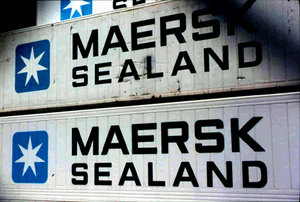The world's top 10 carriers enjoyed a combined global market share of 60 per cent in 2006, up from 49.3 per cent in 2000, according to a new survey from a French shipping consultancy.
That's an increase of 21.7 per cent, said the report compiled by AXS-Alphaliner, which added that the top 10 carriers' combined fleet size had risen from 2.54 million TEU to 6.28 million TEU over the period.
The Liner Shipping Report shows that the world's top three ocean liners, Maersk Line, MSC and CMA CGM, have increased their collective global market share from 32.4 per cent to 33.1 per cent in 2006 in terms of TEU carrying capacity.

This compares to a combined market share of 23.7 per cent on January 1, 2000 for the three leading container shipping companies, which back then were Maersk Sealand, Evergreen and P&O Nedlloyd.
What's interesting about this growth is that Maersk Line commanded the largest global market share of 16.8 per cent at the beginning of this year, down from 18.2 per cent a year ago. The experts attribute this downturn to the integration difficulties Maersk faces in integrating P&O Nedlloyd.
Both MSC and CMA CGM are said to have "strongly" strengthened their positions, with MSC raising its global market share from 8.6 per cent to 9.5 per cent in 2006. CMA CGM increased its share from 5.6 per cent to 6.5 per cent during the same period.
"It looks like the size and coverage extent of these two carriers give them more confidence in the future than smaller carriers, and they are probably in a better position to sustain lower rates, thanks in part to economies of scale and through distinct commercial flair. It will allow them to drain cargo from smaller competitors and to continue growing faster than the rest," the report said.
The report plotted the movements in market share focussing on the global container shipping industry between January 2000 and January 2007. The findings indicate that during this period the world's shipping lines doubled the TEU capacity deployed on the various trades, from 5.15 million TEU to 10.47 million TEU, an increase of 103 per cent.
The analysts point out that this sharp rise in capacity has meant shipping lines have had to boost the carrying capacity of their fleet by 103 per cent in order to maintain their market share. Failure to purchase newbuilds or charter additional vessels has resulted in lost market share.
The results highlight the rise and fall of some of the world's top players by comparing the ratio between market shares at January 1, 2000 and January 1, 2007. The four success stories of this period are: CMA CGM, CSCL, MSC and Hapag Lloyd.
During these past seven years, CMA CGM recorded growth of 174 per cent with its market share rising from 2.4 per cent to 6.5 per cent, with organic growth accounting for more than 80 per cent of this growth.
CSCL's market share has risen from 1.67 per cent to 3.82 per cent, up 127.8 per cent, purely through organic growth. MSC's market share has climbed from 4.4 per cent to 9.8 per cent. Hapag-Lloyd's market share grew from 2.0 per cent to 4.4 per cent, with the acquisition of CP Ships in 2005 accounting for around three-quarters of this growth.
In fifth place is the CSAV Group, whose market share rose from 1.4 per cent to 2.4 per cent in part due to the acquisitions of Norasia and the Norsul liner services, as well as organic growth.
The world's largest shipping line in terms of fleet capacity with 1.76 million TEU, the AP Moeller-Maersk Group, however, is ranked in eighth place for market share growth, primarily due to its takeover of Royal P&O Nedlloyd which rapidly swelled its market share from 12.5 per cent to 18 per cent. Last year, the company's market share dropped to 16.8 per cent.
Hamburg Sud, PIL and IRIS Lines are said to have performed well during this seven-year period and significantly increased their global market share, on the back of strong regional growth.
The levels of market share controlled by Japanese lines NYK, MOL and K Line are said to have remained about the same.
Others have faired far worse. Take for example the Evergreen Group, which in 2000 ranked second with a fleet of 318,000 TEU. Its global market share has dropped 15 per cent from 6.2 per cent to 5.2 per cent despite its fleet size rising to 547,000 TEU in the seven-year period.
Cosco Container Lines shed nine points from its market share during 2000 and 2005 but has been regaining ground since mid-2005 after being listed on the Hong Kong Stock Exchange.





 RELATED
RELATED